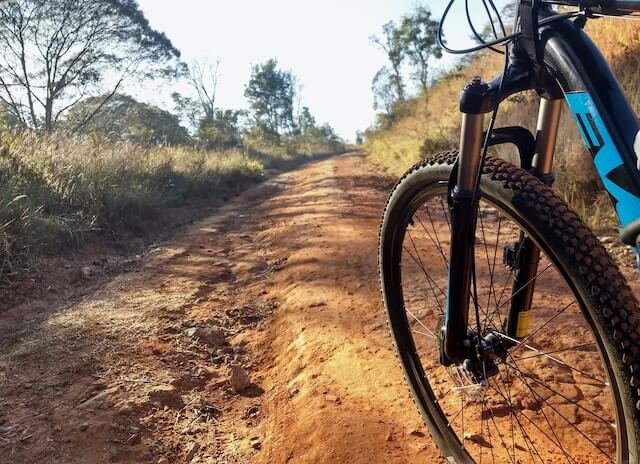Mountain biking has become a widespread outdoor pursuit and competitive sport, characterized by traversing rugged, unpredictable landscapes on specialized off-road bicycles known as mountain bikes. The essence of mountain biking lies in conquering natural trails, navigating rough terrain, and tackling obstacles like rocky inclines and dense forests. This thrilling activity offers both adventure and a rigorous physical challenge, making it a favorite among outdoor enthusiasts seeking adrenaline-fueled escapades amidst nature’s untamed beauty.
Mountain bikes are equipped with features that make them well-suited for off-road riding, such as:
Sturdy frame: Mountain bikes have strong and durable frames to withstand the rigors of rough terrain.
Knobby tires: The tires have deep, aggressive treads that provide excellent traction on loose or uneven surfaces.
Suspension: Many mountain bikes have suspension systems in the front fork and/or the rear, which absorb shocks and vibrations, enhancing rider comfort and control.
Multiple gears: Gears allow riders to adapt to various inclines and terrain types, enabling efficient pedaling and climbing.
Mountain biking can be enjoyed by people of all skill levels, from beginners to experienced riders, and it offers various disciplines and styles, including:
Cross-country (XC): Focuses on endurance and involves long rides on diverse terrains, often incorporating both climbing and descending.
Downhill (DH): Involves riding downhill at high speeds on steep and challenging trails. Usually, riders are transported to the top of the trail by a vehicle or lift.
Enduro: Combines elements of both cross-country and downhill, featuring timed downhill sections and untimed climbs.
Freeride: Emphasizes creativity and style, with riders performing tricks and jumps on natural or manufactured obstacles.
Trail riding: Involves exploring scenic trails, often with some technical sections, but not as extreme as downhill or freeride.
All-mountain: Focuses on versatility and tackling a variety of terrains, including climbs, descents, and technical sections.
Mountain biking not only provides a thrilling experience and a way to connect with nature but also offers various health benefits, such as improved cardiovascular fitness, strength, balance, and coordination. However, due to the potential risks associated with off-road riding, it is essential for mountain bikers to wear appropriate safety gear, follow trail etiquette, and adhere to local regulations to ensure a safe and enjoyable experience for everyone involved.
HOW MOUNTAIN BIKING STARTED
Mountain biking as a sport and recreational activity can be traced back to the 1970s. The origins of mountain biking are often attributed to a group of enthusiasts in Northern California who started modifying and riding their bikes off-road.
The specific moment often regarded as the birth of mountain biking occurred in the late 1960s and early 1970s. During this time, a group of cyclists in Marin County, California, began riding old cruiser bikes and modified balloon-tire bicycles on rough mountain trails. Hikers and horseback riders originally used these trails. The riders, including pioneers like Joe Breeze, Gary Fisher, Tom Ritchey, and others, enjoyed the challenge of navigating the rugged terrain on their bikes.
One key event that helped popularize the sport was the Repack race, organized by Charlie Kelly and Gary Fisher, held in 1976. The name “Repack” came from the need to repack the bike’s coaster brakes with grease after each descent to prevent overheating. This race, held on a steep downhill section of Mount Tamalpais in Marin County, became legendary and inspired more riders to take up off-road cycling.
In the following years, mountain biking gained momentum, and the equipment evolved to meet the demands of off-road riding. Manufacturers began producing purpose-built mountain bikes with features like multiple gears, knobby tires, and stronger frames to handle rough terrain.
The sport continued to grow throughout the 1980s and 1990s, and today, mountain biking has become a global phenomenon, with various disciplines, events, and a thriving community of enthusiasts around the world. The roots of mountain biking in Northern California and the pioneering efforts of those early riders remain an essential part of its history.
NO MOUNTAINS NEEDED FOR MOUNTAIN BIKING
You do not necessarily need mountains to go mountain biking. While mountain biking was initially developed and gained popularity on mountainous terrains, the sport has expanded to include a wide variety of landscapes and trail types. Mountain biking can be enjoyed in a range of environments, including:
Forests: Many mountain biking trails are in forested areas with varying levels of difficulty, offering a mix of natural obstacles and beautiful scenery.
Parks and Recreational Areas: Numerous parks and recreational areas have designated mountain biking trails that cater to riders of different skill levels.
Deserts: In desert regions, you can find mountain biking trails with unique features, such as sand dunes and rock formations.
Coastal Areas: Some coastal regions offer mountain biking opportunities along cliffs, beach trails, and hilly terrains.
Grasslands and Open Spaces: In more open landscapes, trails can be created to provide a cross-country riding experience.
Urban Settings: Urban mountain biking, also known as urban downhill, involves riding through city streets, stairs, and other manufactured obstacles.
The key is to adapt the type of mountain biking to the terrain available in a particular area. For example, if you are in a flat region, you can enjoy cross-country or trail riding, while areas with more significant elevation changes might offer opportunities for downhill or freeride styles.
Furthermore, trail builders and mountain biking communities worldwide have worked to develop and maintain a vast network of trails suitable for several types of mountain biking across diverse landscapes. As a result, the sport has become accessible to people in different geographical regions, regardless of whether there are mountains nearby.
DANGERS OF MOUNTAIN BIKING
Mountain biking, while an exhilarating and enjoyable activity, comes with inherent risks due to the nature of riding off-road on challenging terrains. Some of the dangers of mountain biking include:
Crashes and Injuries: Mountain biking involves navigating through rough and unpredictable terrains, which increases the likelihood of accidents and crashes. Cyclists may suffer injuries such as cuts, bruises, sprains, fractures, and, in more severe cases, head injuries or concussions.
Trail Hazards: Trails can have various hazards like rocks, tree roots, loose gravel, and uneven surfaces. These obstacles can cause riders to lose control or crash if not approached with caution.
Overexertion and Fatigue: Mountain biking requires physical stamina and endurance, especially during long rides or intense climbs. Overexertion can lead to dehydration, heatstroke, or exhaustion.
Wildlife and Natural Hazards: Depending on the location, mountain bikers might encounter wildlife such as snakes, insects, or large animals, which can be a potential danger. Additionally, natural hazards like sudden weather changes, flash floods, or falling rocks can pose risks.
Mechanical Failures: Mountain bikes undergo significant stress while riding on rough terrain, making mechanical failures possible. Brake failure, chain issues, or problems with suspension can lead to accidents.
Getting Lost or Stranded: In remote or unfamiliar areas, mountain bikers may get lost or stranded if they lose their way or encounter unexpected trail closures.
Collisions with Others: On popular trails, there can be a high volume of mountain bikers, hikers, and other users. Collisions or conflicts between trail users can occur if proper trail etiquette and caution are not observed.
Trail Sustainability and Environmental Impact: Mountain biking can have an impact on the environment, especially in sensitive ecosystems. Erosion, damage to vegetation, and disturbance to wildlife can result from irresponsible trail use.
To minimize the dangers associated with mountain biking, riders should take precautions such as wearing appropriate safety gear (helmet, gloves, knee pads, etc.), knowing their skill level and choosing suitable trails, maintaining their bikes regularly, carrying essential tools and supplies, and being aware of their surroundings. Moreover, learning and adhering to trail rules and etiquette, as well as respecting the environment and other trail users, can help create a safer and more enjoyable mountain biking experience.
HOW TO BECOME A PROFESSIONAL MOUNTAIN BIKER
Becoming a professional mountain biker requires dedication, skill development, and a lot of hard work. Here are some steps to help you pursue a career as a professional mountain biker:
Start Riding: Begin riding as much as possible and develop a passion for mountain biking. Ride on various terrains and challenge yourself to improve your skills.
Learn Basic Skills: Master the fundamental mountain biking skills such as braking, cornering, balancing, and handling diverse types of terrain.
Join Local Riding Communities: Connect with other mountain bikers in your area or join local riding clubs and communities. This will provide opportunities to learn from experienced riders, share experiences, and gain valuable insights.
Participate in Races and Events: Start competing in local races and events to gain race experience and improve your race craft. Racing will also help you gauge your skills against other riders.
Training and Coaching: Consider working with a professional mountain biking coach or attending training camps to refine your skills and get expert guidance on technique and fitness.
Focus on a Discipline: Identify the discipline of mountain biking you want to pursue professionally. It could be cross-country (XC), downhill (DH), enduro, freeride, or another discipline.
Compete at Higher Levels: As your skills improve, participate in regional, national, and even international level competitions to gain exposure, and attract sponsors.
Secure Sponsors: Building relationships with sponsors is crucial for financial support and access to better equipment. Sponsors can help cover race fees, travel expenses, and gear.
Stay Fit and Train: Physical fitness is essential for professional mountain bikers. Maintain a regular training routine that includes strength training, cardio workouts, and flexibility exercises.
Manage Finances: Understand the financial aspects of a professional mountain biking career. Budget your expenses wisely and plan for the long term.
Promote Yourself: Use social media and other platforms to share your riding experiences, race results, and training progress. Creating a strong online presence can attract sponsors and fans.
Stay Persistent: Becoming a professional mountain biker takes time and persistence. Keep working hard, stay dedicated, and keep pushing yourself to improve.
Consider Coaching: As you gain experience and expertise, consider becoming a mountain biking coach to help others and diversify your income streams.
Remember, becoming a professional mountain biker is highly competitive, and success may not come overnight. It requires talent, commitment, and a love for the sport. Be patient, enjoy the journey, and continuously strive to improve your skills and performance.
SOME OF THE LARGEST MOUNTAIN BIKING COMPETITIONS
Several mountain biking competitions are considered among the largest and most prestigious in the United States. These events attract professional and amateur riders from all over the country and sometimes from around the world.
Some of the largest mountain biking competitions in the United States include:
Crankworx Colorado (formerly known as Colorado Freeride Festival): Held in Winter Park, Colorado, Crankworx Colorado is a major freeride mountain biking event featuring various competitions, including slopestyle, downhill, and enduro. Crankworx is an internationally recognized mountain biking festival with events taking place in various locations worldwide.
Sea Otter Classic: This multi-discipline cycling festival held annually in Monterey, California, includes a significant mountain biking component. The Sea Otter Classic hosts cross-country, downhill, dual slalom, and other mountain bike races, drawing a large number of participants and spectators.
USA Cycling Mountain Bike National Championships: Organized by USA Cycling, this prestigious event brings together top mountain bikers from across the country to compete for national titles in cross-country, downhill, and enduro disciplines.
Big Mountain Enduro Series: This series comprises several enduro races held at various locations throughout the United States, showcasing challenging and scenic terrain.
Downieville Classic: Located in Downieville, California, this event is a combination of cross-country and downhill racing. The highlight is the infamous Downieville Downhill, a challenging and grueling 17-mile race with a mix of technical descents and climbs.
Trestle Bike Park Series: Taking place at Winter Park Resort in Colorado, this series includes a variety of downhill and enduro races, attracting riders of all skill levels.
Please note that event details and popularity can change over time, and new competitions may emerge. For the most current information on the largest mountain biking competitions in the United States, it is best to refer to updated sources such as official event websites or relevant mountain biking organizations.
WELL KNOWN MOUNTAIN BIKERS
Several mountain bikers have achieved fame and recognition for their exceptional skills, achievements, and contributions to the sport. It is important to note that the popularity of mountain bikers can vary over time and is subject to changes in the sport’s landscape.
Some of the most famous mountain bikers as of that time included:
Aaron Gwin: A renowned downhill mountain biker known for his speed and dominance in the sport. He has won numerous World Cup races and is considered one of the best downhill riders of his generation.
Rachel Atherton: An exceptional downhill mountain biker from the UK, Rachel Atherton has a remarkable record with multiple World Cup wins and World Championship titles.
Nino Schurter: Hailing from Switzerland, Nino Schurter is one of the most successful cross-country mountain bikers in history. He has won numerous World Cup races and Olympic medals.
Danny MacAskill: A Scottish trials mountain biker, Danny MacAskill gained widespread fame through his jaw-dropping and innovative street trials riding showcased in viral videos.
Brandon Semenuk: Known for his outstanding skills in slopestyle mountain biking, Brandon Semenuk has won multiple Red Bull Rampage events and is highly regarded for his creativity on a bike.
Anne-Caroline Chausson: A former French mountain biker who excelled in downhill and 4X (four-cross) disciplines. She has a record-breaking number of World Championship and World Cup titles.
Tahnée Seagrave: A talented British downhill mountain biker known for her aggressive riding style and competitive spirit.
Sam Hill: An Australian enduro and downhill mountain biker, Sam Hill is a legend in the sport, with numerous World Cup and World Championship wins to his name.
Jolanda Neff: A Swiss cross-country mountain biker who has achieved success in both World Cup racing and the Olympics.
Cam Zink: An American freeride mountain biker, Cam Zink is known for his daring stunts and innovative tricks in slopestyle and freeride competitions.
These riders and others have significantly impacted the mountain biking community through their skills, achievements, and contributions to the sport. However, please keep in mind that the popularity and fame of mountain bikers can change over time due to the dynamic nature of the sport and the emergence of new talents.
GETTING STARTED MOUNTAIN BIKING
Getting started with mountain biking can be an exciting and rewarding journey. Here is a step-by-step guide to help you begin:
Get a Suitable Bike: Start by getting a mountain bike that fits your needs and budget. Consider factors like the type of riding you want to do (cross-country, downhill, etc.), your skill level, and the terrain on which you will be riding.
Safety Gear: Invest in essential safety gear, including a properly fitted helmet, gloves, knee pads, and appropriate clothing for riding.
Choose the Right Trails: Look for beginner-friendly trails in your area. Many trail systems have various levels of difficulty, so pick trails that match your skill level.
Learn Basic Skills: Practice fundamental mountain biking skills such as braking, cornering, and shifting gears. Start on flat and easy terrain to build your confidence.
Ride with Experienced Riders: Join local riding groups or clubs to ride with more experienced mountain bikers. Riding with others can be both fun and a wonderful way to learn from those with more knowledge.
Take a Lesson or Clinic: Consider taking a mountain biking lesson or attending a clinic to receive formal instruction from a qualified instructor. They can help you progress faster and avoid common mistakes.
Practice Regularly: The more you ride, the more you will improve. Regular practice is essential for building skills and confidence.
Explore New Trails: As you become more comfortable, venture out to explore new trails and terrain to keep the experience fresh and challenging.
Stay Safe and Respect the Environment: Always follow trail rules and etiquette, respect other trail users, and be mindful of the environment. Leave no trace and avoid damaging trails or wildlife.
Keep Learning: Mountain biking is a continuous learning process. Watch videos, read articles, and seek advice from experienced riders to keep improving.
Have Fun: Remember that mountain biking is about having fun and enjoying the outdoors. Do not be too hard on yourself; embrace the challenges and enjoy the ride!
If you are unsure about certain aspects of mountain biking, consider seeking guidance from a local bike shop or experienced riders. They can provide valuable advice on bike selection, gear, and finding suitable trails. Starting with a positive attitude and a willingness to learn will set you on the path to becoming a skilled and passionate mountain biker.
Remember always seek guidance when starting anything like mountain biking.
If you liked this Share It!
Unleash your BOHOtude – visit BOHOtude Apparel for a selection of free-spirited apparel.























